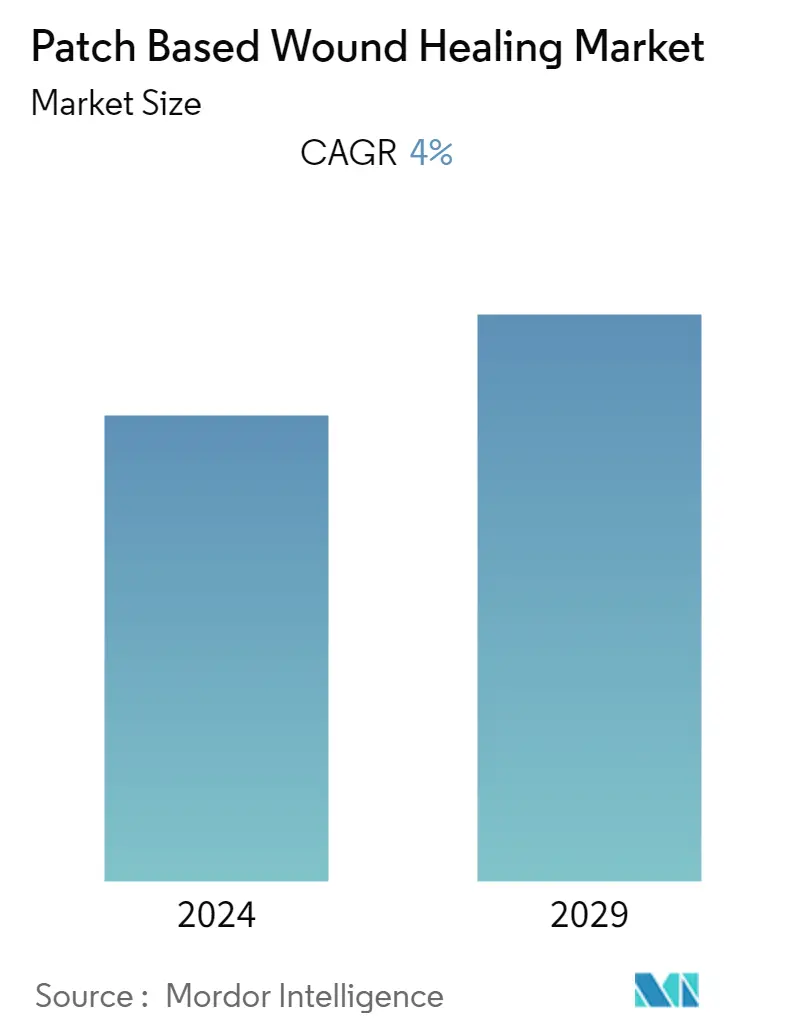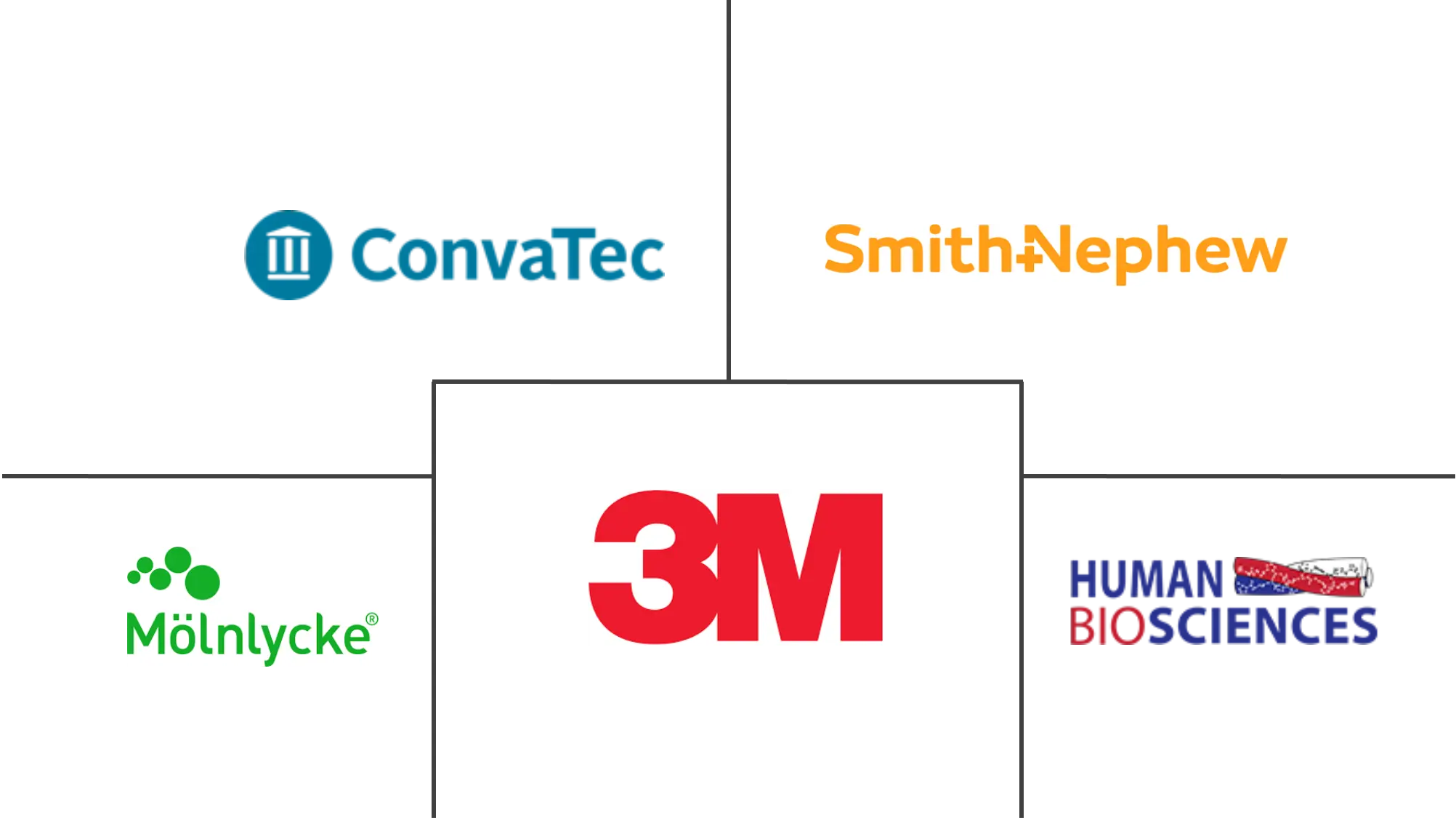Market Size of Patch Based Wound Healing Industry

| Study Period | 2019 - 2029 |
| Base Year For Estimation | 2023 |
| CAGR | 4.00 % |
| Fastest Growing Market | Asia Pacific |
| Largest Market | North America |
| Market Concentration | Medium |
Major Players
*Disclaimer: Major Players sorted in no particular order |
Patch Based Wound Healing Market Analysis
The patch-based wound healing market is expected to register a CAGR of 4.0% during the forecast period.
The COVID-19 pandemic impacted the growth of the patch-based wound healing market. The declined number of transport injuries and burns, as well as elective surgeries cases, due to the lockdown measures imposed by the government across the countries, reduced the demand for wound healing patches during the pandemic. Due to the pandemic and associated restrictions, healthcare settings such as hospitals and specialty clinics temporarily closed their wound care services. According to an article published by the Dermatological Practical and Conceptual in January 2021, the outbreak had a detrimental impact on the majority of dermatology services, leading to a considerable decrease in the amount of time spent consulting with chronic patients suffering from diabetic ulcers. Thus, the decreased consulting time spent with chronic patients resulted in a significant drop in patient visits, which also impacted the demand for treatment and services related to wounds and reduced the demand for patches. However, resumed services and the high number of road accidents increased patient visits to hospitals and clinics, which further propelled the demand for various types of patches, such as collagen formulation patches, povidone-iodine formulation patches, and other patches. Thus, the studied market is expected to regain its full potential in the next 2-3 years.
Factors such as the increasing geriatric population and rising prevalence of diabetes, accidents, and burns, along with new product launches with advanced technologies and a preference for instant wound healing products, are boosting the market's growth.
The rising number of accidents and burn cases is the key factor driving the demand for various types of wound-healing patches. As per the StatBel statistics published in June 2022, there were 34,640 road traffic accidents in 2021, bringing the total casualties to 42,566, including 38,952 slightly injured and 3,098 seriously injured, in Belgium. As per an article published in the JFPMC in March 2022, about 1 million cases of moderate to severe burn injuries requiring high-quality medical care are recorded annually in India. Thus, the high burden of accidents and burns among the population may lead to minor or major wounds that need the care to prevent infection. This trend is expected to increase the demand for wound healing patches, propelling the market's growth.
Increasing government initiatives to launch awareness programs are also contributing to the market's growth. For instance, Wounds Australia developed the Wound Awareness Week (WAW21) campaign in 2021 to educate people regarding chronic wound complications and raise awareness about the risks, warning signs, and treatments. In 2022, the campaign focused on the solutions needed to drive national change for those living with wounds.
Therefore, owing to these factors, the studied market is expected to grow over the forecast period. However, the highly expensive procedures and treatment and unfavorable reimbursement policies are expected to restrain the growth of the patch-based wound healing market over the forecast period.
Patch Based Wound Healing Industry Segmentation
As per the scope of the report, patch-based wound healing care comprises products that are used to treat various types of acute wounds and chronic wounds where the skin is removed, cut, and perforated. Patch-based wound healing products are made of different types of materials such as povidone-iodine, collagen, and silver, among others. Different types of patches are available as sheets and dressings that can be used for specific types of wounds, reducing the risk associated with the infection without occluding the wound.
The patch-based wound healing market is segmented by formulation (povidone-iodine, silver, collagen, and other formulations), application (chronic wounds and acute wounds), and geography (North America, Europe, Asia-Pacific, Middle East and Africa, and South America). The market report also covers the estimated market sizes and trends for 17 countries across major regions globally. The report offers the value (in USD million) for the above segments.
| By Formulation | |
| Povidone-iodine | |
| Silver | |
| Collagen | |
| Other Formulations |
| By Application | |
| Chronic Wounds | |
| Acute Wounds |
| By Geography | ||||||||
| ||||||||
| ||||||||
| ||||||||
| ||||||||
|
Patch Based Wound Healing Market Size Summary
The patch-based wound healing market is poised for growth, driven by factors such as an increasing geriatric population, a rising prevalence of diabetes, and a surge in accidents and burn cases. The market experienced a temporary setback during the COVID-19 pandemic due to reduced demand from decreased transport injuries, burns, and elective surgeries. However, the resumption of healthcare services and the high incidence of road accidents have since propelled demand for various types of wound healing patches, including those with collagen and povidone-iodine formulations. The market is expected to regain its full potential in the coming years, supported by new product launches featuring advanced technologies and a growing preference for instant wound healing solutions.
North America is anticipated to witness significant growth in the patch-based wound healing market, fueled by the increasing burden of diabetes, accidents, and burns in the region. The high incidence of diabetic wounds and ulcers, coupled with a substantial number of road traffic accidents, is driving the demand for effective wound healing patches. The market is moderately competitive, with major players like ConvaTec Inc., Human BioSciences Inc., Molnlycke Health Care AB, 3M Company, and Smith & Nephew actively engaging in product innovations and strategic acquisitions to strengthen their market positions. Despite challenges such as high treatment costs and unfavorable reimbursement policies, the market is expected to expand, driven by the rising adoption of collagen-based patches and increasing awareness initiatives.
Patch Based Wound Healing Market Size - Table of Contents
-
1. MARKET DYNAMICS
-
1.1 Market Overview
-
1.2 Market Drivers
-
1.2.1 Increasing Geriatric Population and Rising Prevalence of Diabetes, Accidents, and Burns
-
1.2.2 New Product Launches with Advanced Technologies and Preference for Instant Wound-healing Products
-
-
1.3 Market Restraints
-
1.3.1 Highly Expensive Treatment and Procedures
-
1.3.2 Unfavorable Reimbursement Policies
-
-
1.4 Porter's Five Forces Analysis
-
1.4.1 Threat of New Entrants
-
1.4.2 Bargaining Power of Buyers/Consumers
-
1.4.3 Bargaining Power of Suppliers
-
1.4.4 Threat of Substitute Products
-
1.4.5 Intensity of Competitive Rivalry
-
-
-
2. MARKET SEGMENTATION (Market Size by Value - USD million)
-
2.1 By Formulation
-
2.1.1 Povidone-iodine
-
2.1.2 Silver
-
2.1.3 Collagen
-
2.1.4 Other Formulations
-
-
2.2 By Application
-
2.2.1 Chronic Wounds
-
2.2.2 Acute Wounds
-
-
2.3 By Geography
-
2.3.1 North America
-
2.3.1.1 United States
-
2.3.1.2 Canada
-
2.3.1.3 Mexico
-
-
2.3.2 Europe
-
2.3.2.1 Germany
-
2.3.2.2 United Kingdom
-
2.3.2.3 France
-
2.3.2.4 Italy
-
2.3.2.5 Spain
-
2.3.2.6 Rest of Europe
-
-
2.3.3 Asia-Pacific
-
2.3.3.1 China
-
2.3.3.2 Japan
-
2.3.3.3 India
-
2.3.3.4 Australia
-
2.3.3.5 South Korea
-
2.3.3.6 Rest of Asia-Pacific
-
-
2.3.4 Middle East and Africa
-
2.3.4.1 GCC
-
2.3.4.2 South Africa
-
2.3.4.3 Rest of Middle East and Africa
-
-
2.3.5 South America
-
2.3.5.1 Brazil
-
2.3.5.2 Argentina
-
2.3.5.3 Rest of South America
-
-
-
Patch Based Wound Healing Market Size FAQs
What is the current Patch Based Wound Healing Market size?
The Patch Based Wound Healing Market is projected to register a CAGR of 4% during the forecast period (2024-2029)
Who are the key players in Patch Based Wound Healing Market?
ConvaTec Inc, Molnlycke Health Care AB, 3M, Smith & Nephew plc and Human BioSciences Inc are the major companies operating in the Patch Based Wound Healing Market.

